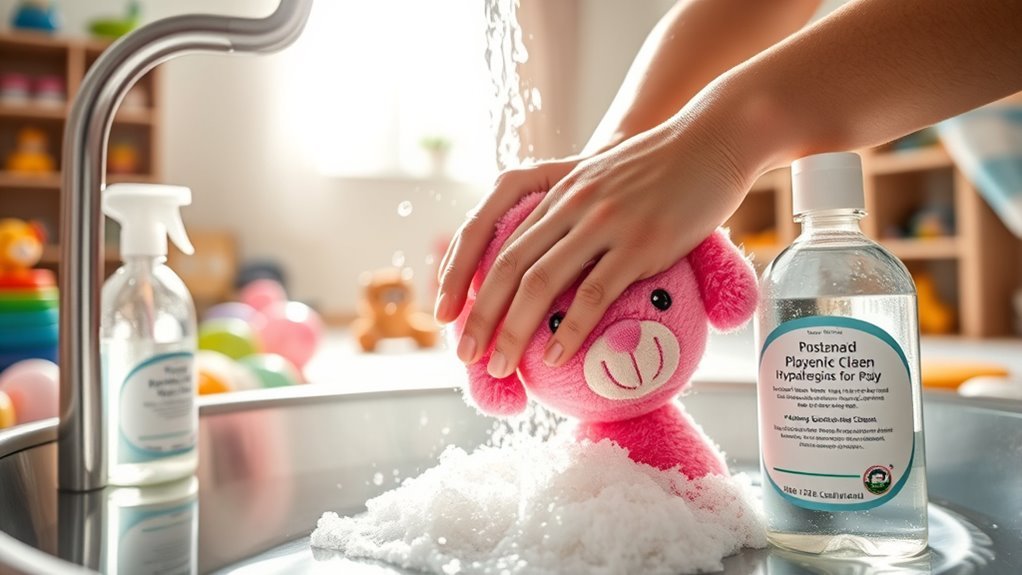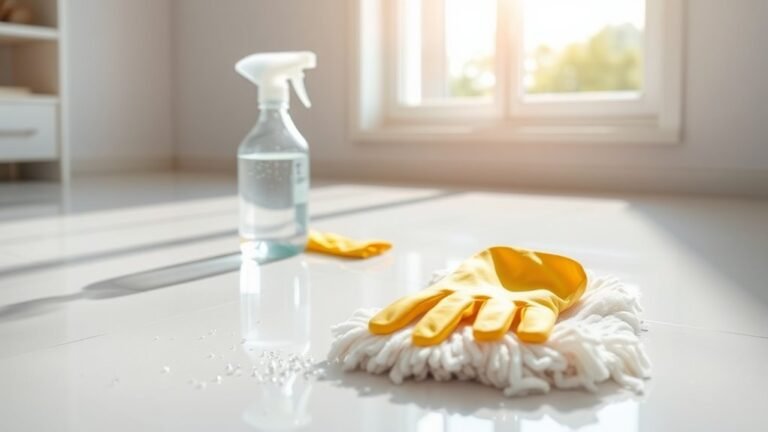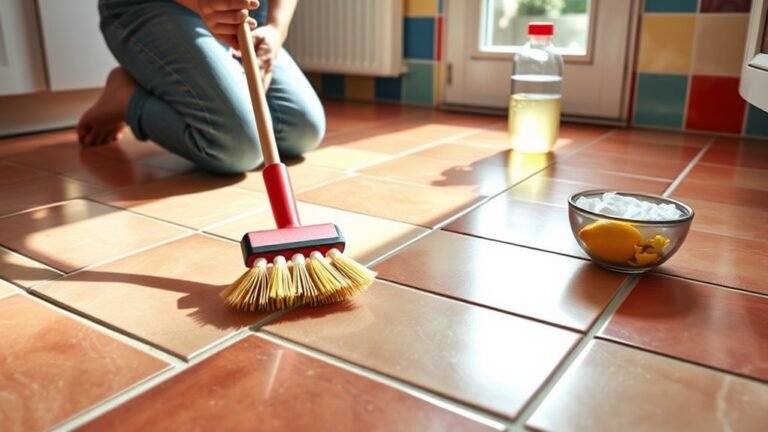Removing Allergens From Toys Effectively
You can effectively remove allergens from your child’s toys by regularly cleaning according to material: wash plush toys gently with mild detergent and dry thoroughly, wipe plastic and hard surfaces with eco-friendly cleaners or alcohol-based disinfectants, and avoid harsh bleach on delicate items. Store toys in airtight containers off the floor to reduce exposure. Establish daily and weekly cleaning routines, inspect for damage, and replace worn toys to maintain a healthier environment. Understanding these practices will help you better protect your child’s play area.
Common Allergens Found on Children’s Toys
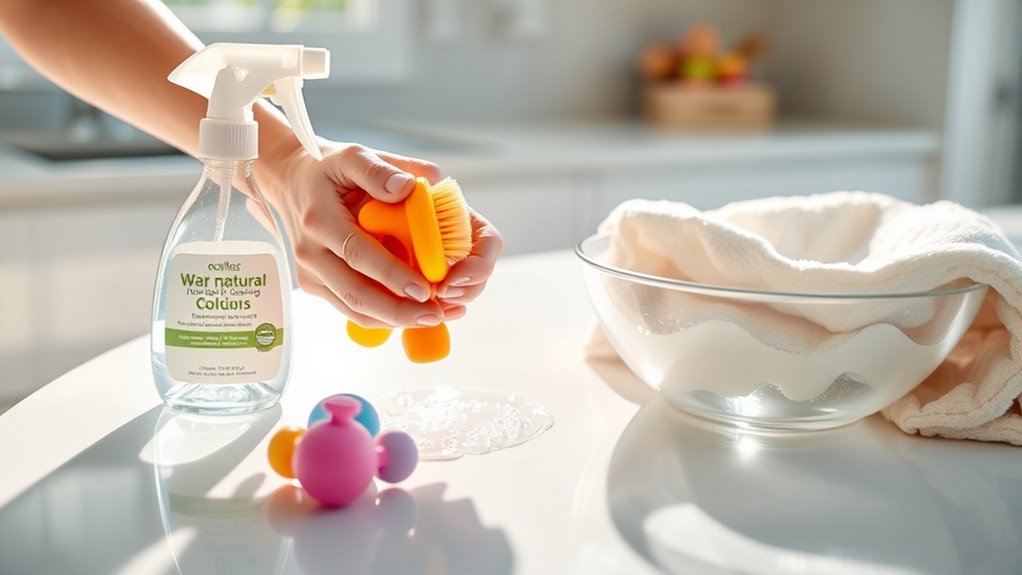
Many children’s toys can harbor a variety of allergens, including dust mites, pet dander, mold spores, and pollen particles. These allergen sources commonly accumulate on toys made from common materials such as plush fabric, foam, and plastic with textured surfaces. Plush toys, for example, provide a hospitable environment for dust mites and mold spores due to their fibrous nature and moisture retention. Plastic toys, while less absorbent, can still collect pollen and pet dander, especially in crevices and grooves. Understanding these allergen sources is vital for effectively reducing exposure and maintaining a safe play environment. By recognizing how common materials contribute to allergen retention, you can make informed decisions about cleaning and selecting toys, ultimately enhancing the freedom to enjoy a healthier living space for your child. Regular cleaning, including washing soft toys and wiping down plastic ones, is essential to minimize allergen buildup and maintain a safe environment for children, especially in homes with multiple pets.
Identifying High-Risk Toys for Allergen Accumulation
Understanding which toys are more likely to harbor allergens helps you focus cleaning efforts where they matter most. High risk materials such as fabric, plush, and porous plastics tend to accumulate dust mites, pet dander, and pollen more readily. Additionally, toy age influences allergen load; older toys often have higher allergen buildup due to prolonged exposure and wear. Identifying these factors enables targeted allergen removal.
| Toy Material | Allergen Accumulation Risk |
|---|---|
| Fabric/Plush | High – traps dust and dander |
| Porous Plastic | Moderate – retains residues |
| Hard Plastic | Low – smooth, less absorbent |
| Rubber/ Silicone | Low – non-porous, easy to clean |
Safe Cleaning Solutions for Different Toy Materials
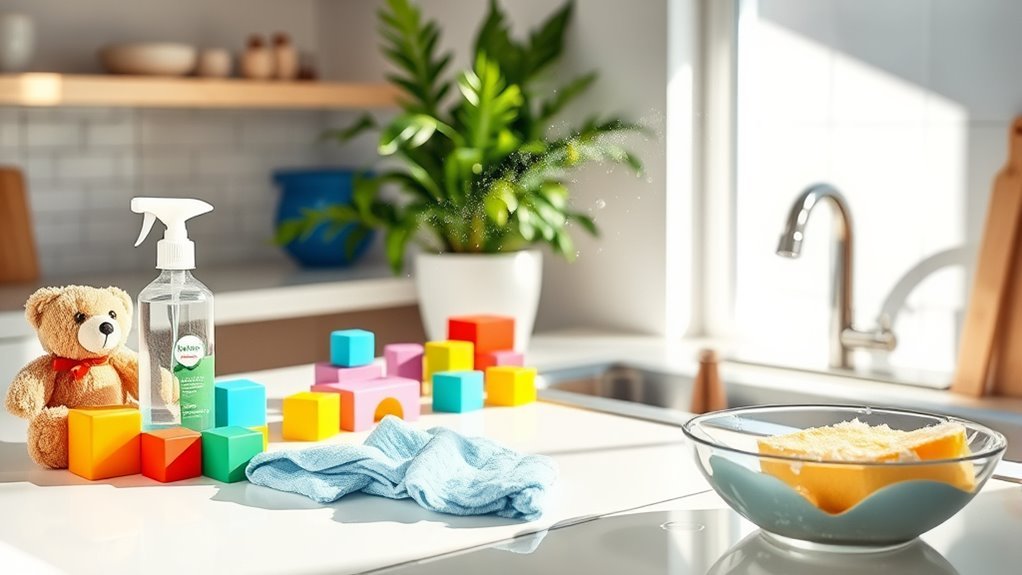
Since different toy materials vary in their ability to harbor allergens, selecting appropriate cleaning solutions is crucial to effectively reduce allergen presence without damaging the toys. For hard plastics and non-porous surfaces, you can use eco friendly cleaners with antimicrobial properties that safely break down allergens without harsh chemicals. Avoid bleach-based products that may degrade materials or cause irritation. For wooden toys, opt for allergen free sprays formulated to clean without excessive moisture, preserving the wood’s integrity. Silicone and rubber toys tolerate mild soap solutions combined with allergen free sprays, which neutralize allergenic proteins effectively. Always test any product on a small area first to verify compatibility. Tailoring your cleaning approach to each material helps maintain toy safety and guarantees a healthier environment free from allergen buildup. It is also important to clean high-touch areas frequently to minimize allergen and germ accumulation on toys.
Washing Techniques for Plush and Fabric Toys
Three key steps guarantee effective allergen removal from plush and fabric toys: gentle washing, thorough rinsing, and complete drying. You can opt for machine washing if the toy’s label permits; use a mild detergent on a delicate cycle with cold water to preserve fabric integrity while reducing allergens. Alternatively, hand washing offers control—you’ll submerge the toy in soapy water, gently agitate it, then rinse thoroughly until no soap residue remains. Avoid harsh chemicals that may damage fibers or trigger sensitivities. After washing, make certain of complete drying by air-drying in a well-ventilated space or using a low-heat setting in a dryer, preventing moisture retention that fosters allergen growth. By carefully choosing your washing method, you maintain both toy safety and allergen reduction, granting your child a healthier play environment. Using gentle fabric cleaners specially formulated for plush toys can further protect softness and color while effectively cleaning.
Disinfecting Plastic and Hard Surface Toys
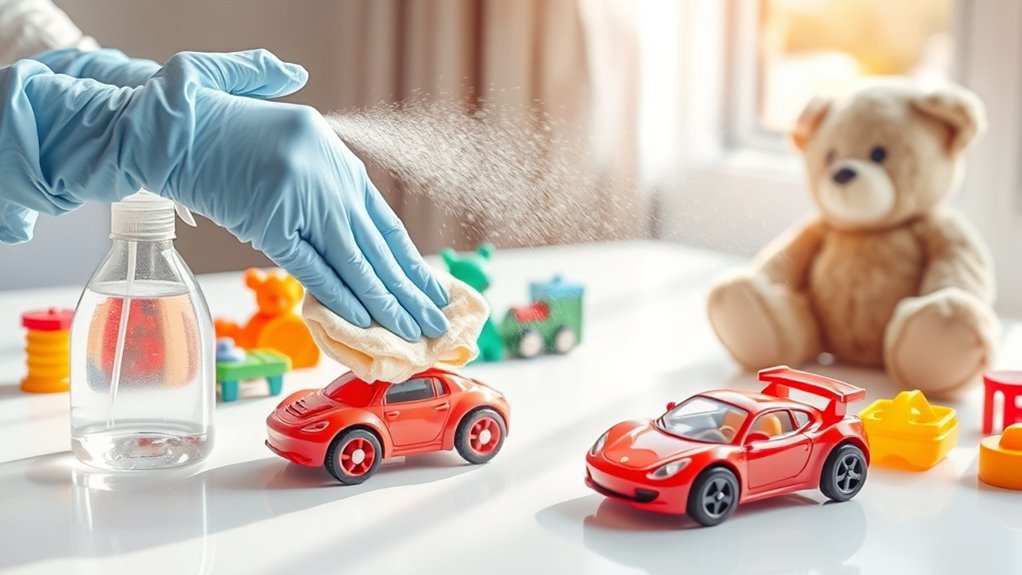
When disinfecting plastic and hard surface toys, you should use safe cleaning solutions like diluted bleach or alcohol-based cleaners to effectively eliminate allergens and pathogens. Applying proper disinfection techniques, such as thorough wiping and allowing sufficient contact time, guarantees maximum efficacy. After cleaning, make sure to dry toys completely and store them in a clean, dry environment to prevent allergen accumulation. For best results and to avoid damage, use mild soap and water as recommended for plastic toys.
Safe Cleaning Solutions
Although plastic and hard surface toys are durable, they can harbor allergens and microbes that require careful disinfection. To protect your family while preserving the environment, consider safe cleaning solutions based on natural ingredients. Eco friendly options like vinegar, baking soda, and diluted hydrogen peroxide effectively reduce allergens without harsh chemicals. These agents disrupt microbial membranes and neutralize allergens without leaving toxic residues. Avoid bleach or ammonia, which can cause respiratory irritation and damage surfaces over time. When selecting products, look for those labeled non-toxic and biodegradable, ensuring both efficacy and environmental responsibility. By choosing natural, eco friendly disinfectants, you maintain a healthy play environment and support your freedom to care for your home sustainably.
Proper Disinfection Techniques
Effective disinfection of plastic and hard surface toys requires a systematic approach to guarantee allergens and microbes are thoroughly eliminated. You should start by selecting appropriate disinfection methods, such as using EPA-approved disinfectants or diluted bleach solutions, ensuring they are safe for the toy materials. Apply the disinfectant evenly, allowing sufficient contact time—usually around 5 to 10 minutes—to achieve effective sanitization. Avoid rinsing prematurely, as this reduces antimicrobial efficacy. For intricate toy parts, use a soft brush to reach crevices where allergens accumulate. Always follow manufacturer guidelines to prevent damage. By adhering to these precise disinfection methods, you maintain a safe play environment without compromising your freedom to choose efficient, scientifically validated cleaning techniques that protect health while preserving toy integrity.
Drying and Storage Tips
Since moisture can promote microbial growth and allergen buildup, thoroughly drying plastic and hard surface toys after disinfection is critical. You’ll want to employ effective drying methods such as air drying on a clean rack or using a lint-free towel to remove residual dampness. Once dry, selecting appropriate storage containers is essential to maintain allergen-free conditions and prevent recontamination.
| Drying Methods | Storage Containers |
|---|---|
| Air drying (natural) | Airtight plastic bins |
| Towel drying (lint-free) | Containers with ventilation |
| Quick drying with fans | Labelled and regularly cleaned |
Preventative Measures to Minimize Allergen Build-Up
You should establish regular cleaning routines to reduce allergen accumulation on toys effectively. Additionally, storing toys properly in sealed containers or designated areas limits exposure to airborne allergens. These preventative measures are essential for maintaining a safer environment for children sensitive to allergens. Incorporating daily cleanup routines can make these practices more manageable and consistent over time.
Regular Cleaning Habits
Although allergens can accumulate quickly on toys, establishing regular cleaning habits greatly reduces their presence and limits exposure. To maintain a healthier environment, you should develop consistent cleaning schedules tailored to the type of toys and materials involved. Effective toy maintenance involves:
- Daily Wipe-Downs: Use a damp cloth with mild detergent to remove surface allergens.
- Weekly Deep Cleans: Submerge washable toys in warm, soapy water or use a disinfectant safe for children’s items.
- Monthly Inspections: Check for wear and tear that can harbor allergens and replace or repair as needed.
Proper Toy Storage
When toys aren’t stored properly, allergens can accumulate quickly, increasing exposure risks. To minimize allergen build-up, effective toy organization is essential. You should select storage solutions that protect toys from dust, mold, and pet dander. Closed containers with airtight seals are ideal, as they limit airborne allergen infiltration. Clear bins allow you to quickly identify contents without opening, reducing unnecessary exposure. Additionally, storing toys off the floor prevents contact with carpet allergens and moisture. Regularly decluttering and rotating toys also reduces allergen reservoirs, making cleaning more manageable. By implementing strategic toy organization and choosing appropriate storage solutions, you maintain a cleaner environment that supports your freedom from allergens while keeping play areas safe and inviting. Proper storage is a proactive step in thorough allergen control.
Storage Tips to Keep Toys Allergen-Free
Since allergens can accumulate quickly on toys, proper storage is essential to minimize exposure. To maintain a clean environment, focus on effective toy organization and use allergen free containers designed to limit dust and microbial contamination. Here are three key storage tips to keep toys allergen-free:
- Use airtight, allergen free containers to prevent airborne particles and allergens from settling on toys.
- Label containers clearly to guarantee toys are returned promptly, reducing exposure time outside protected storage.
- Store containers in a cool, dry place to inhibit mold growth and the proliferation of dust mites.
Additionally, regular washing and sanitizing of toys using safe cleaning methods helps remove allergens and bacteria effectively.
When to Replace Toys to Protect Your Child’s Health
A key aspect of safeguarding your child’s health involves knowing the right time to replace their toys. Regularly performing a health impact assessment on toys helps identify wear, damage, or contamination that may harbor allergens or bacteria. Toy replacement indicators include visible cracks, discoloration, persistent odors, or materials that no longer clean effectively. When you notice these signs, it’s vital to act promptly to prevent allergen buildup and potential health risks. Additionally, consider the toy’s age and usage frequency; older toys often accumulate allergens beyond surface cleaning capabilities. By monitoring these indicators and conducting periodic assessments, you guarantee a safer play environment. Taking this proactive approach supports your child’s freedom to play without compromising their health due to hidden allergens or deteriorated toy conditions. Incorporating regular cleaning routines with gentle detergents and thorough rinsing can significantly reduce allergen buildup and extend the safe use of toys.
Frequently Asked Questions
Can Allergies From Toys Cause Long-Term Health Issues in Children?
If your child is exposed to allergy symptoms triggered by certain toy materials, it can sometimes lead to prolonged respiratory issues or skin conditions. While occasional exposure may cause mild reactions, constant contact with allergens can increase sensitivity and potentially cause long-term health problems. You should monitor symptoms closely and choose hypoallergenic toys to minimize risks. Understanding the specific toy materials involved helps you make safer choices for your child’s well-being.
Are There Specific Allergens More Common in Outdoor Toys?
Imagine you’re a Victorian scientist studying outdoor materials—just like then, pollen, mold spores, and dust mites remain common allergens on today’s outdoor toys. These allergens thrive especially on porous surfaces like wood or fabric. When you practice regular toy maintenance, such as cleaning and drying toys properly, you reduce allergen buildup. Understanding these specifics helps you protect your child’s freedom to play safely outdoors without unnecessary allergic reactions.
How Often Should Allergen Testing Be Done on Children’s Toys?
You should consider allergen testing frequency based on how often your child’s toys are used and cleaned, ideally every three to six months. This schedule helps maintain children’s toy safety by identifying potential allergen buildup early. If your child has known sensitivities, increasing testing frequency is wise. Regular testing guarantees freedom from harmful exposure, letting your child enjoy playtime without compromising health. Stay proactive to keep play environments safe and allergen-free.
Can Air Purifiers Help Reduce Allergens on Toys?
Did you know that indoor air can contain up to 5 times more allergens than outdoor air? While air purifier effectiveness is proven in reducing airborne allergens, their impact on toy allergen reduction is indirect. Air purifiers trap dust and pollen floating in the air, which can settle on toys, but they don’t clean toys themselves. To truly reduce allergens on toys, regular washing and wiping are essential alongside using an air purifier.
Are Hypoallergenic Toys Completely Free of Allergens?
You shouldn’t assume hypoallergenic toys are completely free of allergens. They’re made from hypoallergenic materials designed to minimize allergic reactions, but trace allergens can still be present. Proper toy maintenance, like regular cleaning, is essential to reduce allergens effectively. While these materials reduce risks, no toy can guarantee total allergen absence, so staying vigilant about upkeep helps you keep your environment safer and more comfortable.
